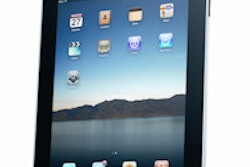
On-call radiologists should feel comfortable using an iPad for interpreting MRI, CT, and radiography studies, according to a recent meta-analysis published in the June issue of the British Journal of Radiology.
With the caveat that all of the studies they evaluated had at least some potential bias or quality issues, an Australian research team found no statistically significant differences in performance for reading CT, MRI, and radiography studies. In a review of 11 studies -- 10 of which evaluated the iPad -- the researchers found sensitivity rates ranging from 84% to 98%, specificity rates of 74% to 100%, and accuracy rates of 98% to 100% for diagnosis.
"There was a near-complete consensus from authors on the noninferiority of diagnostic accuracy of images displayed on a tablet computer," wrote a team led by Liam Caffery, PhD, of the University of Queensland in Brisbane, Australia (Br J Radiol., June 2015, Vol. 88:1050, pp. 20150191).
Systematic review
 Liam Caffery, PhD, of the University of Queensland.
Liam Caffery, PhD, of the University of Queensland.Because there hadn't been an attempt yet to synthesize existing research evidence on the reliability of using tablet computers for radiological interpretation, the research team sought to systematically review the published literature to determine if the use of tablets compromises diagnostic accuracy. They searched the PubMed and EMBASE databases in 2015 with a combination of keywords, medical subject headings, and Emtree terms for radiology, teleradiology, and tablet computers.
Studies were included in the meta-analysis if they calculated either the diagnostic accuracy or diagnostic reliability (i.e., inter-rater/intrarater reliability) of image interpretation on a tablet computer. In addition to assessing the studies for quality as well as risk of bias, the researchers calculated or noted the 95% confidence interval in multireader, multicase receiver operating characteristic (ROC) studies in order to aid comparability.
Of the 11 studies that met their inclusion criteria, 10 involved the use of the iPad while one (from 2005) used a HP TC1000 tablet with a resolution of 1,024 x 768 pixels. Only one of the iPad studies used a model with a retina display (2,048 x 1,536 pixels). The remainder used iPad versions with a resolution of 1,024 x 768 pixels.
Nine studies examined CT and MRI images, while two assessed performance with plain-film radiographs, according to the researchers. Half of the studies compared the performance of the tablet with a PACS display, while the other half employed a secondary LCD as the reference standard. There were eight diagnostic accuracy studies and three diagnostic reliability studies.
"There was no statistically significant difference in accuracy between tablet computers and [DICOM] GSDF-calibrated control displays," they wrote.
The researchers did find that the eight diagnostic accuracy studies were judged to have a high or unclear risk of bias in at least one study domain, with 88% judged to have a high risk of bias for the index test domain.
"This was owing to a number of reasons, including the index test readers not having sufficient number or range of experience to represent a radiologist population; the index test readers not having the same referral information and access to previous imaging as the reference test readers; the index test reader's diagnosis being limited to known type of pathology; and the monitor luminance and ambient lighting of the index test not being comparable to the reference test," they wrote.
Furthermore, each of the three diagnostic reliability studies had at least one item in the study that was judged to indicate a poor quality.
"The reasons for poor quality included readers not being representative of the review's population, blinding of referral and clinical information, nonrandomization of reading order, and the use of binary scales by study readers," the authors noted.
The study results could also not be combined due to factors such as heterogeneity of study designs, methodologies, display characteristics, reader profession, lighting conditions, and the imaging modality being assessed.
Limitations
The authors acknowledged several limitations of their findings, including its reliance on a small number of heterogeneous studies. Furthermore, "The small sample size and the large number of studies judged to be at risk of bias may reduce confidence in the findings of this review," they wrote.
Nonetheless, the authors concluded that, "the findings of this review suggest that the diagnostic accuracy of radiological interpretation was not compromised by using a tablet computer to interpret CT, MRI, or plain radiography."
This conclusion is only applicable to the Apple iPad and indicates this device is suitable for an on-call radiologist to display images for interpretation, they stated.
"I think radiologists will start to push for their institution to provide access to images from their iPad and start to test the water in parallel to how they currently access images on-call," Caffery told AuntMinnieEurope.com.
The authors also noted that local regulatory guidelines may apply to the use of tablet computers for primary diagnosis.
"When considering the usage of a tablet computer for on-call radiology, the user also needs to assess the software functionality -- for example, access to referral information and previous imaging; software stability and network performance," they wrote. "These have all been identified by the authors of included studies as potential impediments in using a tablet computer for radiological interpretation."


















